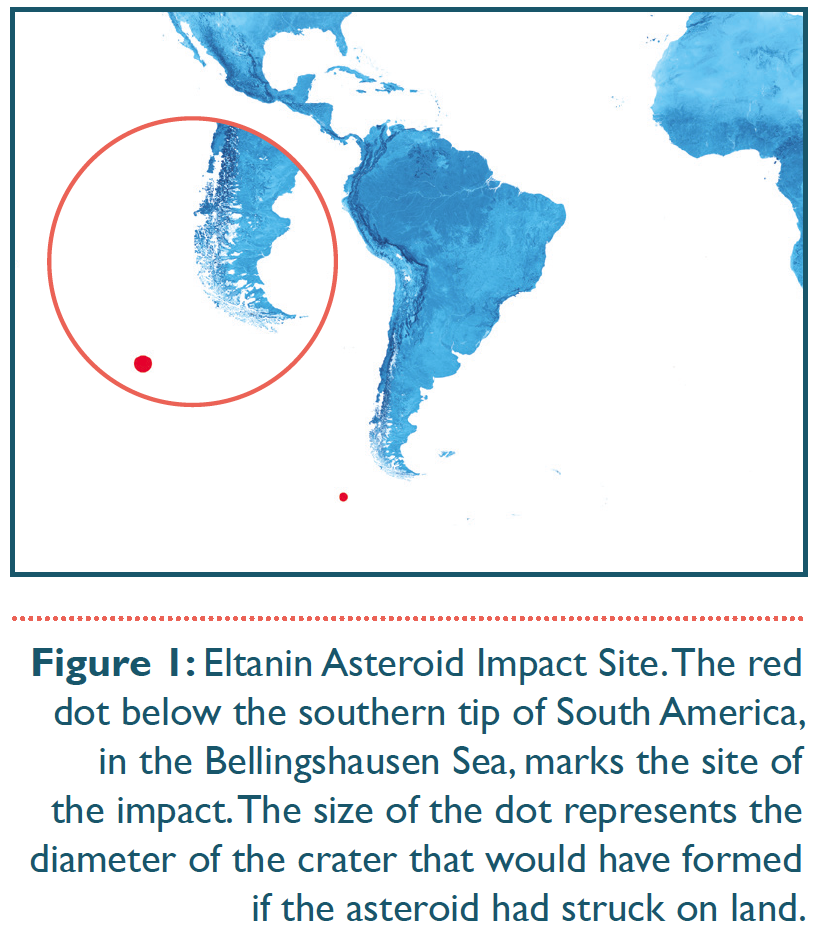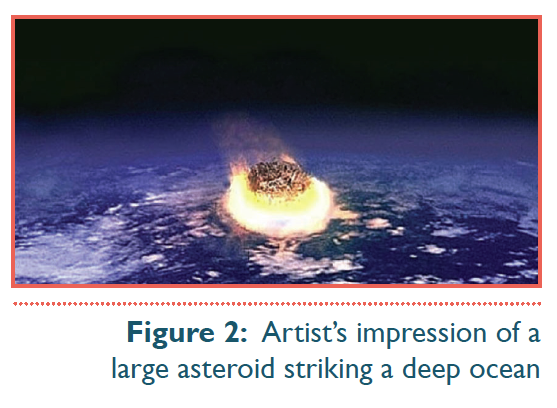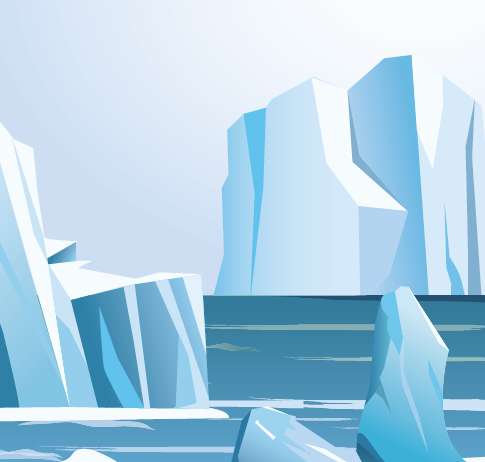The Great "'Cene Change" That Made Civilization Possible
Theater aficionados know that noise and commotion behind the curtain during the intermission of a theatrical performance intensify anticipation. Then, when the curtain rises again, the audience sees that the scene has been radically altered, and the "wow" factor is heightened. Earth's scene (or "'cene") has also changed dramatically in history to bring about surprising changes for humanity's benefit.
The 'cene that we and the rest of Earth's inhabitants are seeing right now is the Pleistocene, the epoch during which ice coverage of our planet varies in a patterned way, the era of "the ice age cycle." For the past 2.58 million years, Earth has cycled at regular, repeated intervals of between 10 percent surface ice coverage and 20–23 percent.
The Pleistocene was preceded by the Pliocene, an epoch during which the global mean temperature gradually cooled and continents merged—Africa with Asia and North America with South America. During a very brief intermission between the Pliocene and the Pleistocene, some of the greatest commotion Earth has ever experienced occurred. Scientists now recognize that this commotion must have been extremely fine-tuned and perfectly timed to set the stage for our present-day civilization.
The Pliocene geologic epoch extended from 5.33 to 2.58 million years ago. The Pleistocene extends from 2.58 million years ago to today.
The Pliocene was characterized by a gradual cooling and drying of the global climate and by a global mean temperature about 3°C (5°F) warmer than today's. Sea levels were about 30 meters (100 feet) higher, and while ice sheets were beginning to form over Antarctica and Greenland, no ice age cycle yet existed.
What Started the Pleistocene?

In 1964, the USNS Eltanin, an oceanographic research vessel, recovered deep-sea core E13-3 (a sample of sediment extracted from the ocean floor) from a depth of 5,090 meters (16,700 feet) in the Antarctic Ocean. In 1981, researchers studying E13-3 discovered that it contained an abundance level of iridium (a very dense, corrosion-resistant platinum group element) that was far too high for terrestrial rocks but was typical of asteroids in sediments.2 Two geophysicists and a chemist at UCLA who studied that core sample detected a gold-to-iridium ratio known to be unique to chondritic meteorites.
The same three scientists published a follow-up study in 1988.3 They reported that debris from the impact of this object spread across at least 600 kilometers (375 miles) of ocean floor. Based on iridium concentrations found in sediments from six deep-sea cores, they concluded that the colliding asteroid must have been at least 0.5 kilometer (0.3 mile) in diameter.
In 1995, the research vessel Polarstern returned to the Eltanin impact site. During this expedition, scientists successfully collected three more cores containing deposits from the impact. Analysis of the geological record within the region of impact yielded an approximate impact date of 2.15 million years ago.4 The same analysis altered estimates of the asteroid's size, upping it to at least one kilometer (0.6 mile) in diameter. The calculated explosive force from such an asteroid smashing into Earth's deep ocean is equivalent to the explosion of at least 100 billion tons of TNT. For comparison, the entire global nuclear arsenal has the explosive force of 6.4 billion tons of TNT.
In 2001, Polarstern returned again to the impact site. The Polarstern crew explored a region of 80,000 square kilometers (about 31,000 square miles), and collected 17 additional sediment cores containing meteoritic ejecta. At the 2005 fall meeting of the American Geophysical Union, geophysicists Frank Kyte, Rainer Gersonde, and Gerhard Kuhn presented a summary of the results from the 2001 expedition.5
The three geophysicists reported that the known field of meteorite fragments extends over a region of 660 by 200 kilometers (51,000 square miles). Interestingly, they found "no evidence that the impactor had penetrated to the ocean floor or formed a crater."6 However, they did find extensive evidence that melted ejecta had mixed with seawater salts. Their analysis of all the data from the 2001 expedition led them and others to confirm that the impactor was at least 1 kilometer, but not larger than 2 kilometers, in diameter.7
Analysis of over 20 deep-sea sediment cores in the impact region yielded a much more reliable date for the impact as well. Chronostratigraphic data (dating the ages of layers) from these cores place the Eltanin impact sometime after the Gauss Chron date of 2,581,000 years ago but before the C2r.2r event date of 2,441,000 years ago.8 This impact date of 2,511,000 ±70,000 years ago is consistent with the date for the beginning of the ice age cycle, a date established by decree by the International Commission on Stratigraphy on June 30, 2009.9
Real Climate Change

When Goff's team reviewed all the existing data on mega-tsunami deposits in Antarctica, Chile, Australia, and New Zealand, they found that the Eltanin impact event consistently explained all this data. The team's computer modeling established that in addition to generating mega-tsunamis throughout the South Pacific Ocean, this impact would have ejected enormous amounts of water vapor, sea salts, sulfur, and dust up into the stratosphere, where it would have remained for at least two years.
The research team showed that this quantity of material in the stratosphere would cause two climate-changing consequences. First, the albedo, or reflectivity, of the top of Earth's atmosphere would be greatly increased. Therefore, more of the Sun's heat and light would be reflected away from Earth. Second, the opacity of Earth's atmosphere would also be increased, meaning less of the Sun's light and heat would be able to reach Earth's surface. Both consequences would have quickly and drastically reduced Earth's surface temperatures.
Eltanin's impact, and its occurrence soon after the five major tectonic plate movements, which had their own cooling effects,11 radically and rapidly accelerated global cooling. Goff's team showed that the Eltanin impactor so powerfully accelerated global cooling as to hurtle Earth into the cycle of glaciations that has persisted for the past 2.58 million years. Their conclusion: Without the Eltanin impactor, there would be no ice age cycle. If there were no ice age cycle, several requirements for the launch and maintenance of global civilization would have been lacking (see sidebar). In other words, without Earth's precise scene ('cene) change—by an impactor of just the right size and composition, perfectly timed and perfectly placed—there would be no global, sizable, high-technology human civilization.
Notes
1. Hugh Ross, Improbable Planet: How Earth Became Humanity's Home (Baker, 2016), 200–204.
2. Frank T. Kyte, Zhiming Zhou, and John T. Wasson, "High Noble Metal Concentrations in a Late Pliocene Sediment," Nature 292 (July 30, 1981), 417–420.
3. Frank T. Kyte, Lei Zhou, and John T. Wasson, "New Evidence on the Size and Possible Effects of a Late Pliocene Oceanic Asteroid Impact," Science 241, no. 4861 (July 1, 1988), 63–65.
4. R. Gersonde et al., "Geological Record and Reconstruction of the Late Pliocene Impact of the Eltanin Asteroid in the Southern Ocean," Nature 390 (November 27, 1997), 357–363.
5. F. T. Kyte, R. Gersonde, and G. Kuhn, "Summary of Results from Analyses of Deposits of the Deep-Ocean Impact of the Eltanin Asteroid," American Geophysical Union, Fall Meeting 2005 (December 2005).
6. Kyte, Gersonde, and Kuhn, "Summary of Results," ibid. note 5.
7. Kyte, Gersonde, and Kuhn, "Summary of Results," ibid. note 5; Valery Shuvalov and Rainer Gersonde, "Constraints on Interpretation of the Eltanin Impact from Numerical Simulations," Meteoritics & Planetary Science 49, no. 7 (July 2014): 1171–1185; James Goff et al., "The Eltanin Asteroid Impact: Possible South Pacific Palaeomegatsunami Footprint and Potential Implications for the Pliocene-Pleistocene Transition," Journal of Quaternary Science 27, no.7 (October 2012), 660–670.
8. T. Frederichs et al., "Revised Age of the Eltanin Impact in Southern Ocean," American Geophysical Union, Fall Meeting 2002 (December 2002).
9. Philip L. Gibbard and Martin J. Head, "The Newly-Ratified Definition of the Quaternary System/Period and Redefinition of the Pleistocene Series/Epoch, and Comparison of Proposals Advanced Prior to Formal Ratification," Episodes: Journal of International Geoscience 33 (September 2010), 152–158, also available at stratigraphy.org/GSSP/Gelasian3.pdf; Philip Leonard Gibbard and Martin J. Head, "IUGS Ratification of the Quaternary System/Period and the Pleistocene Series/Epoch with a Base at 2.58 MA," Quaternaire 20, no. 4 (December 2009), 411–412.
10. James Goff et al., "The Eltanin Asteroid Impact," ibid. note 7.
11. Ross, Improbable Planet, ibid. note 1.

Benefits of the Ice Age Cycle for Civilization
1. Melting ice fields and glaciers left over from the previous glacial episode water the great agricultural plains.
2. Melting ice fields and glaciers deliver nutrient-rich alluvial silt to the agricultural plains.
3. Volcanic eruptions at the end of the previous glacial episode deliver nutrient-rich ash and dust to agricultural regions.
4. Wind-blown dust from high plateaus that were covered by ice bring additional nutrients to the agricultural plains.
5. The retreat of ice sheets from the previous glacial episode created a vast network of lakes and rivers that transformed Canada, Siberia, and Scandinavia from deserts into lush forests.
6. The geological relief created by the retreat of ice fields and glaciers produced an abundance of waterfalls that can be exploited for producing electricity.
7. Retreating ice sheets formed land bridges that facilitated human migration and colonization.
8. The retreat of ice sheets and glaciers created large, safe harbors to facilitate trade.
9. The retreat of ice sheets and glaciers exposed rich ore deposits.
10. The retreat of ice sheets and glaciers created gravel-bed river floodplains and wetlands that sustain abundant and diverse populations of birds and mammals.
11. The retreat of ice sheets and glaciers created habitats for a high population of beavers. Beaver activity helps to remove toxins and pollutants from water supplies.
12. Retreating ice sheets and glaciers created spectacular scenery.
Source: Ross, Improbable Planet, 209–212.
Hugh RossPhD, is an astrophysicist and the founder and president of the science-faith think tank Reasons to Believe (RTB).
Get Salvo in your inbox! This article originally appeared in Salvo, Issue #49, Summer 2019 Copyright © 2026 Salvo | www.salvomag.com https://salvomag.com/article/salvo49/dramatic-direction



















